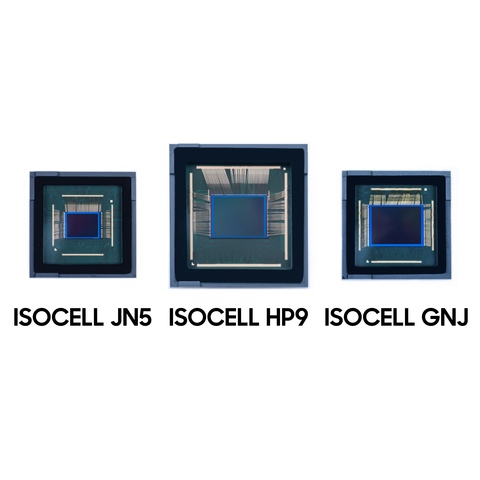New lineup features industry-leading 200MP and 50MP sensors, bridging the gap between main and sub cameras for enhanced imaging across all angles
SEOUL, South Korea — (BUSINESS WIRE) — June 27, 2024 — Samsung Electronics Co., Ltd., a world leader in advanced semiconductor technology, today announced three new mobile image sensors designed for both main and sub cameras in smartphones: the ISOCELL HP9, the ISOCELL GNJ and the ISOCELL JN5.
This press release features multimedia. View the full release here: https://www.businesswire.com/news/home/20240627343229/en/

Samsung Unveils Versatile Image Sensors for Superior Smartphone Photography (Photo: Business Wire)
As user expectations for smartphone camera quality and performance continue to rise, Samsung's latest image sensors deliver stunning results from every angle, setting a new standard for mobile photography.
"Enhancing image sensor performance and bridging the gap between main and sub cameras to offer a consistent photography experience across all angles is the new direction of the industry," said Jesuk Lee, Executive Vice President and CTO of the System LSI Sensor Business Team at Samsung Electronics. "We will continue to set industry standards and push technological boundaries with our new lineup of mobile sensors that integrate the latest advancements."
ISOCELL HP9: The Industry's First 200MP Telephoto Sensor for Smartphones
The ISOCELL HP9 features 200 million 0.56-micrometer (μm) pixels in a 1/1.4-inch optical format.
With its proprietary high-refractive microlens featuring a new material, the HP9 significantly enhances light-gathering capability by directing more light accurately to the corresponding RGB color filter. This results in more vivid color reproduction and improved focus with 12% better light sensitivity (based on signal-to-noise ratio 10) and 10% improved autofocus contrast performance compared to the previous product.
Notably, the HP9 excels in low-light conditions, addressing a common challenge for traditional telephoto cameras. Its Tetra²pixel technology merges 16 pixels (4x4) into a large, 12MP 2.24μm-sized sensor, enabling sharper portrait shots — even in dark settings — and creating dramatic out-of-focus bokeh1 effects.
As main cameras in premium smartphones grow in size, the room for telephoto cameras is also increasing. The HP9's large optical format makes it suitable for telephoto modules, delivering performance that matches premium main cameras in image quality, autofocus, high dynamic range (HDR) and frames per second (fps).
Powered by a remosaic algorithm, the HP9 offers 2x or 4x in-sensor zoom modes, achieving up to 12x zoom when paired with a 3x zoom telephoto module, all while maintaining crisp image quality.
ISOCELL GNJ: Integrating Cutting-Edge Pixel Technology Innovations
The ISOCELL GNJ is a dual pixel sensor with 50 million 1.0μm pixels in a 1/1.57-inch optical format.
Each pixel houses two photodiodes, enabling fast and accurate autofocus, similar to the way human eyes focus. The image sensor also simultaneously captures full color information for quick focusing with sustained image quality.
The GNJ combines dual pixel technology with an in-sensor zoom function to deliver clearer footage in video mode and higher-resolution images free from artifacts or moiré2 patterns in photo mode.
The newly improved high-transmittance anti-refractive layer (ARL), coupled with Samsung's proprietary high-refractive microlense, not only boosts light transmission and reduces unwanted reflections but also ensures that dark areas are not overly brightened for more accurate photos with well-preserved image details.
In addition, the GNJ includes an upgraded pixel isolation material in deep trench isolation (DTI) from polysilicon to silicon oxide, minimizing crosstalk between adjacent pixels. This allows the sensor to capture more detailed and precise images.
All of these innovations have been achieved with less power consumption, featuring a 29% improvement in preview mode and 34% in video mode at 4K 60fps.
ISOCELL JN5: Consistent Camera Experience From Every Angle With Broad Color Range and Excellent Autofocus
The ISOCELL JN5 features 50 million 0.64μm pixels in a 1/2.76-inch optical format.
Dual vertical transfer gate (Dual VTG) technology increases charge transfer within pixels, substantially reducing noise in extreme low light conditions for clearer image quality.
Leveraging Super Quad Phase Detection (Super QPD), the JN5 adjusts focus by comparing phase differences both vertically and horizontally, catching even the smallest details of rapidly moving objects with minimal shake.
Additionally, the JN5 incorporates dual slope gain (DSG) technology to enhance its HDR. This technology amplifies the analog light information entering the pixels into two signals, converts them into digital, and then combines them into one data, expanding the range of colors that the sensor can produce.
Implementing hardware remosaic algorithms improves camera shooting speed while enabling real-time zoom in both preview and capture modes without any delay.
The JN5's slim optical format makes it highly versatile, allowing it to be used across main and sub cameras —including wide-angle, ultra-wide-angle, front and telephoto — promising a consistent camera experience from various angles.
About Samsung Electronics Co., Ltd.
Samsung inspires the world and shapes the future with transformative ideas and technologies. The company is redefining the worlds of TVs, smartphones, wearable devices, tablets, home appliances, network systems, and memory, system LSI, foundry and LED solutions, and delivering a seamless connected experience through its SmartThings ecosystem and open collaboration with partners. For the latest news, please visit the Samsung Newsroom at news.samsung.com.
1 Bokeh refers to the blur produced in out-of-focus objects in a photo, generally to an aesthetically pleasing degree.
2 The moiré effect is an undesirable visual phenomenon that occurs when repetitive details (usually lines) are photographed.
View source version on businesswire.com: https://www.businesswire.com/news/home/20240627343229/en/
Contact:
Ujeong Jahnke
Samsung Semiconductor Europe GmbH
Tel. +49(0)89-45578-1000
Email:
sseg.comm@samsung.com








